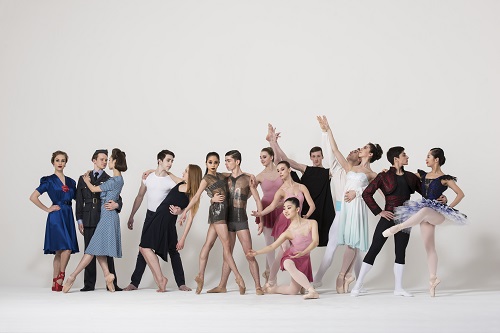 United Kingdom Various composers, Ballet Central Tour 2016: Dancers of Ballet Central. Redgrave Theatre, Bristol, 16.7.2016. (JO’D)
United Kingdom Various composers, Ballet Central Tour 2016: Dancers of Ballet Central. Redgrave Theatre, Bristol, 16.7.2016. (JO’D)

Celebration
Dancers: Marven Douglas, Emma Hancox, Mia Labuschagne, Elizabeth Meadway, Kanami Sano, Jasper Arran, Thomas Badrock, Cian Hughes, Mark Samaras, Joseph Vaughan
Choreography: Christopher Gable CBE
Insinuare
Dancers: Prima Tharathep and Joseph Vaughan
Choreography: Leanne King
Repetition (2) Change
Dancers: Stephanie Gomm, Mai Ito, Seren Williams, Thomas Badrock, Cian Hughes, Mark Samaras
Choreography: Sharon Williams
Superstruct
Dancers: Morven Douglas, Elizabeth Meadway, Valerie Yeo, Jasper Arran, Thomas Badrock, Joseph Vaughan
Choreography: Sara Matthews
Pas de Trois from Paquita
Dancers: Mai Ito, Kanami Sano, Mark Samaras
Choreography: Marius Petipa
This Time Now
Dancers: Emma Denham, Paddy Randall, Alexandra Davies, Elizabeth Meadway, Prima Tharathep, Joseph Vaughan
Choreography: Leanne King
War Letters
Dancers: Holly Girdham, Emma Hancox, Mai Ito, Mia Labuschagne, Kanami Sano, Prima Tharathep, Seren Williams, Jasper Arran, Thomas Badrock, Cian Hughes, James Roxby-Brown, Mark Samaras, Joseph Vaughan
Choreography: Christopher Marney
Ballet Central, made up of third-year students from the Central School of Ballet, began its 2016 tour in March. Bristol’s Redgrave Theatre was the penultimate stop before a performance at the Stratford Circus Arts Centre in London on the 30th July. The programme of seven works shows dancers at the start of their careers in a range of styles that includes classical and neoclassical ballet, contemporary dance, the jitterbug and the conga.
The women are in tiaras and pointe shoes for Celebration, the opening work by Central School of Ballet’s co-founder, Christopher Gable. The men wear white, with turquoise-coloured sashes at the waist. This was not the work in which the largest number of dancers looked most comfortable, but there was a poignancy to its music (piano and the sound of bells) and to the port de bras of all its young performers. Kanami Sano was confident in the jeté. Mark Samaras gave energy to the dancers around him.
Leanne King’s Insinuare, a duet vigorously performed by Prima Tharathep and Joseph Vaughan, was followed by Sharon Watson’s Repetition (2) Change, the re-working of a piece created for Phoenix Dance Theatre in 2013. Though its costumes are no less unwieldy, it is sharper and clearer this time round. Seren Williams and Mia Labuschagne brought force and meaning to the movement. Joseph Vaughan floated horizontally in the air. Cian Hughes was Puck-like in his jumps. The demanding footwork of Sara Matthews’s Superstruct was also deftly performed, with Jasper Arran, in particular, showing musicality and ballon.
Mai Ito raised her chin in an expert manner before beginning to dance in the Pas de Trois from Paquita, one of Marius Petipa’s 1881 additions to a ballet he choreographed in 1847. Mark Samaras seemed to capture the movement of a male dancer in the mid, rather than late, nineteenth century. This may have been a reflection of Petipa’s own thoughts of the past when he created the piece.
The company’s performance in Bristol included a piece, choreographed by Leanne King, in which four dancers from Ballet Central were joined by two neurosurgery patients at Bristol Children’s Hospital. Emma Denham and Paddy Randall were admitted to the hospital in the same year. Both had brain Arteriovenous Malfunction; both were training to be dancers. Neuro-surgeon Mike Carter, who spoke to the audience at the start of the evening, decided to use dance as a form of neurological rehabilitation. Dressed in white, the two guest dancers moved with, and sometimes between, the black-clad Ballet Central dancers: different, yet the same. At times, all the dancers did the touching of the thumb with the fingers test, then put a hand to their forehead. Most moving of all was the moment when Emma Denham sat down at the front of the stage to do this with her back to the audience.
Christopher Marney’s War Letters, after the interval, was disappointing. Commissioned by Ballet Black in 2013, it deals with World War II soldiers and the women they left behind. Neither the choreography, nor the ideas in the piece, sustain interest for the half hour that it lasts; but mature, individual performances by Emma Hancox and James Roxby-Brown stood out. Its conga was danced with unusual lightness and grace …. for a conga.
John O’Dwyer